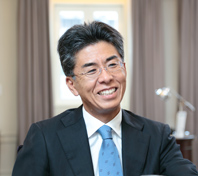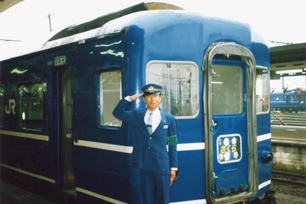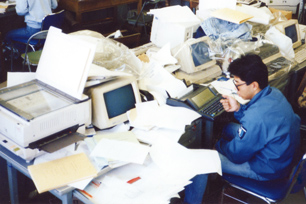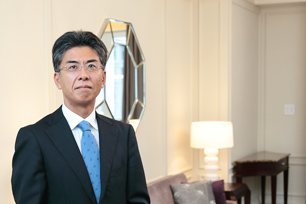Toshio Omiyama, President, Morioka Terminal Building Co., Ltd.
In charge of the renovation and reopening of the historic Tokyo Station Hotel, located inside the Tokyo Station Marunouchi Station Building–a listed Important Cultural Property of Japan.

Toshio Omiyama, President
Morioka Terminal Building Co., Ltd.
An alumnus of Keio Senior High School, Omiyama graduated from the Department of Mechanical Engineering of the Faculty of Science and Technology in 1988. He joined the East Japan Railway Company in April of the same year, and has been involved in hospitality business including the development of GALA Yuzawa Ski Resort, Hotel Mets, Hotel Metropolitan Marunouchi, and resort hotels such as Familio and Folkloro. As for management, he was Executive Assistant Manager in charge of the renewal of Hotel Metropolitan, and from 2009 led the redevelopment of the Tokyo Station Hotel. Currently, he serves as President of Morioka Terminal Building Co., Ltd.
Stepping forward to join the development project, GALA Yuzawa, and also studying abroad at Cornell University

─ Stepping forward to join the development project, GALA Yuzawa, and also studying abroad at Cornell University
Located within the Tokyo Station “Red Brick” Marunouchi Station Building, the much beloved Tokyo Station Hotel has welcomed many guests since the Taisho era. Opened in 1915, the year after Tokyo Station started its operation, this year marks its 100th anniversary. The hotel was temporarily closed from 2006 due to construction work for preservation and restoration of the Tokyo Station Marunouchi Station Building, but reopened in October 2012. Mr. Toshio Omiyama, who presently serves as President of Morioka Terminal Building Co., Ltd., was deeply involved for about 10 years in conceptual work of the Tokyo Station Hotel as well as the day-to-day operation, during the period from before it closed temporarily, while it was being renovated, and until it reopened.
Mr. Omiyama, you are a graduate of the Department of Mechanical Engineering of the Faculty of Science and Technology. Please start by telling us how you ended up in the hotel business.
At the Department of Mechanical Engineering, I studied fluid dynamics, and when I started my career at East Japan Railway Company (JR East) I thought that my research on fluid flow may come in handy, such as in designing the headpart of a Shinkansen. But after joining the company, I was assigned to the rail freight transport division.
JR East had just become a private emtity in 1987, and we were the first employees to be hired after the change. Today, JR East is recognized as a stable company, but back then, no one was sure how it would be after privatization. The first large project we undertook was the development of GALA Yuzawa. This was a grand resort project, as the plan was to open a ski resort on the mountain behind the track maintenance base at Echigo Yuzawa, together with a new Shinkansen station. Stepping forward to participate in the project is was what started my career in resort and hotel development. When I decided to join JR East, I had a desire not to immerse myself in technical things like a manufacturer, but to do something that requires working with people, and I also thought that resort development might be fun. Furthermore, I used to enjoy ski racing as a member of the ski team of the Faculty of Science and Technology Athletic League, so when I heard about a ski resort development, I admit that it excited me.
In those days, to get to a ski resort from the Tokyo metropolitan area it was most common to drive several hours. GALA Yuzawa’s standingwas that it’s a ski resort only 75 minutes from Tokyo. I was in charge of the marketing. We visualized the type of customers that would come to the resort, and simulated what kind of ski courses we should make. In addition, we considered how we should lay out ski lifts to appeal to our customers and how many customers could be anticipated. In dealing with these marketing issues, my scientific side in handling numbers and data proved very useful.
─ When the resort opened in the winter of 1990, it became a hot topic. I think many Keio graduates will fondly recall [the pop group] ZOO’s song “Choo Choo Train.”
What a fond memory! After GALA Yuzawa, I continued to work in resort development, and as inter-company assignment I temporarily worked at Mitsubishi Trust and Banking Corporation [presently Mitsubishi UFJ Trust and Banking Corporation] to study resorts and hotels from a financial standpoint. After that, JR East also provided me with the opportunity to study at the School of Hotel Administration at Cornell University.
Today in Japan, the government emphasizes on the tourism industry, but back then when Japan was promoting itself as a technology-oriented nation, tourism and the hotel industry were still lagging behind other countries. What surprised me at Cornell University was learning that hotel and resort business is so logical. Just like the fast-food industry, the operation was well-established, and efficiency is calculated down to the smallest detail. The classes at Cornell University were practical, mainly handling case studies. I obtained an MMH (Master of Management in Hospitality), which is known as the MBA of the hotel industry.
─ The School of Hotel Administration of Cornell University is internationally acclaimed, and many Keio graduates have studied there.
President Chiaki Tanuma of Green House Co., Ltd. and President Yoshiharu Hoshino of Hoshino Resorts both studied there too, and they are good friends of mine. After returning to Japan, I got to experience actual hotel operation at the Hotel Metropolitan, Ikebukuro and the launch of Hotel Mets, a limited service hotel, and then later on I was assigned to the reopening of the Tokyo Station Hotel.
The exterior is faithful to its original form, while inside it is a modern world-class international hotel
─ The Tokyo Station Marunouchi Station Building, in which Tokyo Station Hotel is located, was designed by Kingo Tatsuno, a leading architect of the Meiji and Taisho eras, and was listed as an Important Cultural Property of Japan in 2003. After being hit by air raids during World War II, the original three-story building was temporarily repaired and was used as a two-story building, but in the recent renovation, the building was restored almost exactly to the original form, including the two domes at both ends.
How did the Tokyo Station Hotel change after the renovation?
In Europe, you can find hotels that use old palaces or castles as a practice of preserving historical architecture by actually utilizing the buildings. Once they are turned into a museum, time stops ticking as a building where history is made. Rather than that, the idea is to keep using it in a practical way to pass it on to the next 100 years.
Based on the same concept, the renewal of the Tokyo Station Hotel went ahead with a policy to enhance hotel functionality while being inside an Important Cultural Property.
A preservation committee was established within JR East, and after careful review at the committee which included scholars and professionals who specialize in history and architecture, we decided to restore the exterior almost exactly to its original form, but as for the interior, partially retain its original features, but change the size of the rooms so they could be equipped with modern hotel amenities.
For the reconstruction of the exterior, we had to manufacture the same bricks as the original ones, but even though the latest technology was used to create the bricks as precisely as possible, for some reason the quality wasn’t as good as the old ones. We had difficulty reproducing the edge of the bricks, which have to be right-angled, and we worked on it for a long time. Also, the way the bricks were laid was very accurate, and even though the building had gone through the Great Kanto Earthquake, it stands strong. As such, I was surprised at the craftsmanship of the Taisho era.
As for the interior of the hotel, in order to realize a cozy atmosphere for people of today as well as to maintain a traditional European style, we appointed Ms. Fiona Thompson, a designer at Richmond International, a company in England that has a lot of experience in renovating hotels that have historical architecture. We were able to achieve a serene interior in which any international customer would feel comfortable.
─ Yes, when you go to a Japanese restaurant in a foreign country, it’s quite often that you feel awkward even though the interior design looks Japanese.
That’s true. As an international hotel, I wanted to eliminate such awkwardness. The European-style functional facilities inside match the external appearance of the station building, which was renovated faithfully. The hotel has added value as a facility within a cultural property while at the same time providing comfort to the guests.
We also focused on being more international in our operations, such as customer service. Since JR East-affiliated hotels have mainly focused on the domestic market and lacked international experience, we scouted the General Manager and many other staff with abundant experience in overseas hotels.
Fortunately, just when we were reopening, we were designated by the Ministry of Foreign Affairs of Japan as anofficial hotel of the IMF General Assembly. Taking advantage of this opportunity, we were able to start smoothly as an international hotel.
Surely, at the same time, we are able to satisfy Japanese customers who feel nostalgic and have an attachment to the Tokyo Station Hotel.
Well-balanced and fulfilling days—Research activities and the Faculty of Science and Technology Athletic League Ski Team

─ What memories do you have of Keio University?
I used to study fluid dynamics, and when I say fluid dynamics, you may picture a wind tunnel experiment, observing the flow of smoke of an incense stick. However, just when I joined the lab, analysis using computers had just started, so my research involved inputting data in the supercomputer, verifying the results, making modifications, and just repeating this process. During that time, I would bring in my sleeping bag and stay over at the lab.
Normally, studying was my top priority, but when winter came, skiing became the center of my life. I used to belong to the Faculty of Science and Technology Athletic League Ski Team, and I would spend those winter days doing nothing but alpine skiing, racing down the slopes of Hakuba, our training camp site.
On the other hand, during summer vacation, I became a certified water safety rescuer of the Japanese Red Cross, and served as a volunteer lifeguard at swimming beachs. People generally acknowledge that the Faculty of Science and Technology always keeps you busy, but I actually had fun skiing and swimming, and led a fulfilling student life other than studying. I think I was able to balance these activities nicely with studying.

─Today, you serve as the president of Morioka Terminal Building Co., Ltd. of the JR East group, working for the Hotel Metropolitan Morioka and the shopping center in Morioka rail station. Please tell us about the appeal of Morioka as a tourist site.
The coastal areas of Iwate are still in the process of recovering from the Great East Japan Earthquake. Many of my tasks are related to recovery, and this spring, we will open a hotel in Kamaishi that will serve as a base for tourism around the coastal areas.
Also, the cherry blossom season in Iwate is right around Golden Week. Within an hour from Morioka, you can enjoy cherry blossom in Kitakami, Tono and Hanamaki if it is a slow year, or, if it blooms earlier than usual you can enjoy the cherry blossom in full bloom at Hachimantai and Appi.
─I guess the cherry blossoms in the Tohoku area must be really beautiful, surrounded by all the abundant nature. I hope tourism will help the recovery of the area. Finally, could you give a message to current Keio University students?
In 2012, when President Seike came to the Tohoku Rengo Mitakai which was held in Morioka, he talked about the importance of deciding a theme, formulating a hypothesis, verifying it, and then forming another hypothesis and investigating it further–this process is the same in academics, sport, and business. Listening to his words, I realized after all these years that the method I learned staying over at the Faculty of Science and Technology and repeating experiments is the same method I am now using in the business of hotel and resort development. The “manner of studying” that you acquire at Keio University will surely be relevant even if you end up working in a field totally different from your major, just like I did. So, I hope you all enjoy studying as well as club activities, and make the most of your student life.
─Thank you very much.
*Position titles, etc., are those at the time of publishing.
